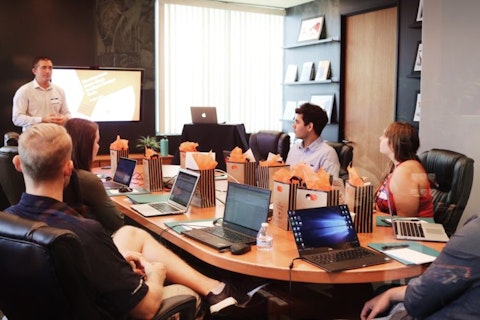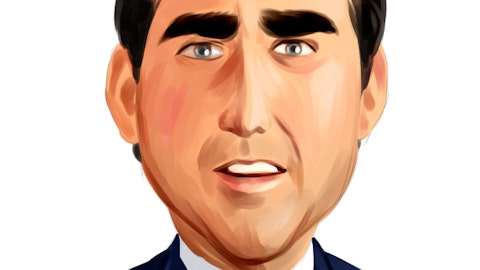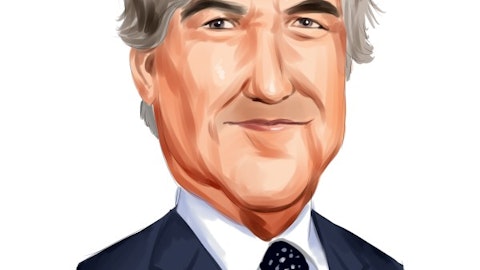Exponent, Inc. (NASDAQ:EXPO) Q4 2022 Earnings Call Transcript February 2, 2023
Operator: Good day, and welcome to Exponent’s Fourth Quarter and Fiscal Year 2022 Financial Results Conference Call. All participants will be in listen only mode . Please note this event is being recorded. I would now like to turn the conference over to Joni Konstantelos. Please go ahead.
Joni Konstantelos: Thank you, operator. Good afternoon, ladies and gentlemen. Thank you for joining us on Exponent’s Fourth Quarter and Fiscal Year 2022 Financial Results Conference Call. Please note that this call will be simultaneously webcast on the Investor Relations section of the company’s corporate Web site at www.exponent.com/investors. This conference call is the property of Exponent and any taping or other reproduction is expressly prohibited without prior written consent. Joining me on the call today are Dr. Catherine Corrigan, President and Chief Executive Officer; and Rich Schlenker, Executive Vice President and Chief Financial Officer. Before we start, I would like to remind you that the following discussion contains forward-looking statements, including, but not limited to, Exponent’s market opportunities and future financial results that involve risks and uncertainties that may cause actual results to differ materially from those discussed here.
Additional information that could cause actual results to differ from forward-looking statements can be found in Exponent’s periodic SEC filings, including those factors discussed under the caption Risk Factor in Exponent’s most recent Form 10-K or 10-Q. The forward-looking statements and risks in this conference call are based on current expectations as of today, and Exponent assumes no obligation to update or revise them, whether as a result of new developments or otherwise. And now I will turn the call over to Dr. Catherine Corrigan, Chief Executive Officer. Catherine?
Catherine Corrigan: Thank you, Joni, and thank you, everyone, for joining us today. I will start off by reviewing our fourth quarter and fiscal year 2022 business performance, Rich will then provide a more detailed review of our financial results and outlook for 2023, and we will then open the call for questions. We delivered solid results in fiscal year 2022, growing net revenues by 7% year-over-year and expanding earnings per diluted share. In a year marked with evolving macroeconomic challenges and uncertainty, we continued to showcase the strength and resiliency of our business model. We saw strong demand across the business for Exponent’s diversified portfolio of services through 2022. On the proactive side, our work in the consumer products, electronics, automotive and life sciences sectors were key contributors for the year.
On the reactive side, we saw robust litigation related activity and a diversified portfolio of product safety and recall related work spanning multiple industries. As innovation and technology become increasingly complex, the critical nature of our insights uniquely positions Exponent to address our clients’ needs throughout the product life cycle. Turning to our engagements in more detail. Within our proactive services, we saw strong demand for our working user experience research and machine learning data studies across multiple industries. Clients look to Exponent for our expertise in understanding the human machine interface from the cognitive impact of virtual and augmented reality to the interactions between vehicle operators and advanced driver assistance systems.
They come to us when they need to acquire the most sophisticated, high quality and curated training data sets to drive machine learning algorithms because getting it right matters when it comes to product performance and safety. We saw increased activity in the life sciences sector related to regulatory issues as well as the safety and efficacy of health care products and treatments. Within the automotive sector, our work with electric vehicles around batteries was a key contributor to our growth year-over-year. Looking at our reactive business, we continued to experience robust demand for our domestic litigation and international arbitrations related work, particularly in the toxic tort and environmental litigation arena as well as advanced driver assistance system litigation.
We saw strong growth in engagements around product safety and recall, particularly in the transportation, life sciences and consumer products industries. Clients are turning to us earlier in their investigation processes in order to benefit from our insights as they make critical product recall decisions. We saw our accelerated recruitment efforts materialize with 6% headcount growth year-over-year. While the landscape for top-tier talent remains highly competitive, we successfully increased headcount in key areas of the business where we have identified the greatest need and opportunity. We are encouraged by our momentum and are focused on strategically building our world class team to position Exponent at the forefront of innovation and to meet the dynamic needs of the market.
Turning to our segments. Exponent’s engineering and other scientific segments represented 83% of our net revenues in the fourth quarter and for the full year. Net revenues in this segment increased 10% in the fourth quarter and 8% during fiscal year 2022 as compared to the prior year period. Growth during the quarter and full year was broad based with continued strong demand for Exponent’s services across the consumer products, electronics, life sciences and automotive sectors. Exponent’s environmental and health segment represented 17% of the company’s net revenues in both the fourth quarter and fiscal year. Net revenues in this segment decreased 2% for the fourth quarter of 2022 and were flat during the full year 2022 compared to the same period in the prior year.
Excluding the impact of foreign exchange, net revenue for the Environmental & Health segment increased 2% in the fourth quarter of 2022 and increased 4% during fiscal year 2022 as compared to the prior year period. Growth in this segment was primarily driven by Exponent’s safety related work, evaluating the impacts of chemicals on human health and the environment. Since our humble beginnings in 1967, Exponent has harnessed the power of technical excellence, objectivity and disciplinary diversity to help unravel the complexities of innovations as they become reality. Looking ahead, we will continue to evolve our differentiated portfolio of services to be at the cutting edge of our clients’ needs. We remain focused on advancing our long term strategy by positioning Exponent to capitalize on disruptive trends and rising societal expectations for safety, health, sustainability, reliability and performance.
I’ll now turn the call over to Rich to provide more detail on our fourth quarter and fiscal year 2022 results as well as discuss our outlook for the first quarter and the full year 2023.
Rich Schlenker: Thank you, Catherine, and good afternoon, everyone. Let me start by saying all comparisons will be on a year-over-year basis unless otherwise noted. For the fourth quarter of 2022, total revenues increased 12.2% to $127.4 million and revenues before reimbursements or net revenues, as I will refer to them from here on, increased 7.9% to $112.6 million as compared to the same period of 2021. The quarter’s net revenue growth was negatively impacted by 0.7% from foreign exchange. Net income for the fourth quarter increased 10.5% to $22.5 million or $0.44 per diluted share as compared to $20.4 million or $0.38 per diluted share in the prior year period. EBITDA for the fourth quarter increased 3.1% to $31.1 million, producing a margin of 27.6% of net revenues, which exceeded our guidance.
We expected the margins as we return to decline as people return to in-person engagement, both our employees and clients. Billable hours in the fourth quarter were approximately 354,000, an increase of 5.7% year-over-year. The average technical full time equivalent employees in the fourth quarter were 989, which is an increase of 7.3% as compared to one year ago. Highlighting our focused recruiting, utilization in the fourth quarter was 69%, down from 70% in the same quarter of 2021 as we continue to balance headcount growth and utilization. The realized rate increase was approximately 2.5% for the fourth quarter as compared to the same period a year ago. In the fourth quarter, compensation expense after adjusting for gains and losses in deferred compensation increased 7.7%.
Included in total compensation expense is a gain in deferred compensation of $6.7 million as compared to a gain of $4.7 million in the same period of 2021. As a reminder, gains and losses in deferred compensation are offset in miscellaneous income and have no impact on the bottom line. Stock based compensation expense in the fourth quarter was $4.3 million as compared to $4 million in the prior year period. Other operating expenses in the fourth quarter were up 6.8% to $9.3 million, driven primarily by increased activities as our employees continue to return to our offices. Included in other operating expenses is depreciation and amortization expense of $1.9 million for the quarter. As expected, G&A expenses were up 49.5% to $7 million for the fourth quarter.
The increase in G&A expenses was primarily due to half the cost of our in-person managers meeting and increased marketing and recruiting activities. Interest income increased to $1.3 million for the fourth quarter. Higher interest income was driven by an increase in interest rates. Miscellaneous income, excluding the deferred compensation gain was approximately $500,000 for the fourth quarter. Moving to our cash flows. During the fourth quarter, we generated $40.6 million in cash from operations and capital expenditures were $2.9 million. During the quarter, we distributed $12.2 million to shareholders through dividend payments and repurchased $13.2 million of common stock at an average price of $87.76. Turning to the full year results. For the year 2022, total revenues increased 10.1% to $513.3 million and net revenues increased 6.7% to $463.8 million as compared to 2021.
Net revenue growth was negatively impacted by 0.5% from foreign exchange. Net income for the year increased 1.1% to $102.3 million or $1.96 per diluted share as compared to $101.2 million or $1.96 per diluted share in 2021. The tax benefit associated with accounting for share based awards for 2022 was $5.8 million or $0.11 per diluted share as compared to $10 million or $0.19 per diluted share in 2021. Inclusive of the tax benefit from share based awards, Exponent’s consolidated tax rate was 22.6% for the full year as compared to 19.6% in 2021. For the year, EBITDA margin — I mean, EBITDA increased 3.8% to $137.2 million, producing a margin of 29.6% of net revenues, which exceeded our guidance as expenses were still below normal in the first half of the year.
Billable hours for 2022 were approximately 1,465,000, an increase of 4.2% year-over-year. Utilization for the full year was 73.8%, down from 75.1% during 2021. Utilization for the full year was in line with expectations, as we increased head count following the pandemic. Average technical full-time equivalent employees for the year were 955, an increase of 6.1% as compared to 2021. The realized rate increase was approximately 2.5% for the year 2022. Compensation expense, after adjusting for gains and losses and deferred compensation, increased 5.7%. Included in total compensation expense is a loss in deferred compensation of $14.1 million as compared to a gain of $14.7 million during 2021. This results in a $28.8 million change year-over-year.
Stock based compensation expense in 2022 was $20.4 million as compared to $19.3 million in the prior year period. Other operating expenses were up 7.6% to $35.1 million. Included in other operating expenses is depreciation and amortization expense of $7.1 million for the full year. As expected, G&A expenses were up 54.8% to $23.7 million in 2022. The increase in G&A expenses was primarily due to the cost of our in-person managers meeting and increased marketing and recruiting activities. Interest income increased approximately $2 million to $2.1 million for the full year. Higher interest rates was driven by an increase in interest rates. Miscellaneous income, excluding the deferred compensation loss was $3.4 million for 2022. Moving to our cash flows.
During 2022, we generated $93.8 million in cash from operations and capital expenditures were $12 million. For the full year, we distributed $49.2 million to shareholders through dividend payments and $155.9 million of share repurchases at an average price of $88.69. As of year end, the company had $161.5 million in cash. Turning to our outlook for the first quarter and full year 2023. We expect first quarter 2023 revenues before reimbursements to grow in the high single to low double digits and EBITDA to be 27.5% to 28.2% of revenues before reimbursements. For the full year of 2023, we expect revenues before reimbursement to also grow in the high single to low double digits and EBITDA margin to be 28% to 28.5% of revenues before reimbursements.

Photo by Campaign Creators on Unsplash
While this is a step down from 2022, it exceeds our pre-pandemic EBITDA margin of 27.4% in 2019 by 60 to 110 basis points. During 2023, we expect the year-over-year growth in technical full time equivalent employees to be 6% to 8%. We are having success in accelerating our recruiting and are pleased that our turnover declined to approximately 16% in 2022 and we expect it to be approximately 15% in 2023. The increased headcount will likely lead to slightly lower utilization. We expect utilization in the first quarter to be 73% to 75% as compared to 76.5% in the first quarter of 2022. We expect full year utilization to be 72% to 74% and as compared to 74% in 2022. We still believe our long term target of sustained mid-70s utilization is achievable as we continue to build critical mass in offices and practices and increase the amount of proactive work.
We expect 2023 year-over-year realized rate increase to be 3% to 4%. We expect the realized rate increase in the first quarter will be at the top end of that range. For the first quarter, we expect stock based compensation expense to be $7 million to $7.3 million and each of the remaining quarters to be $4.8 million to $5.2 million. For the full year 2023, we expect stock based compensation to be $21.5 million to $23 million. For the first quarter, we expect other operating expenses to be $9.5 million to $10 million. For the full year, we expect other operating expenses to be $40 million to $41 million. as we continue to grow our head count and return to our offices. In many of our offices, we are experiencing an increased presence of employees.
We believe our office environment provides long term value as it supports collaboration for our interdisciplinary teams and staff development, which result in higher value for our clients and retention of our employees. For the first quarter, we expect G&A expenses to be $6.4 million to $6.8 million. For the full year 2023, we expect G&A expenses to be $27 million to $27.6 million. As a reminder, travel was still very low in the first half of 2022. So the year-over-year growth in G&A expenses is related to increased headcount recruiting, business development and travel. We expect interest income to be $1 million to $1.4 million per quarter. In addition, we anticipate miscellaneous income to be $600,000 to $800,000 per quarter. For 2023, we estimate based on our current stock price, that our tax benefit associated with share based awards will be approximately $3 million for the first quarter and full year.
As a reminder, we had $5.8 million of tax benefit from share based awards in 2022, so this difference will reduce net income by $2.8 million and earnings per diluted share by $0.06. The tax benefit from share based awards is determined based on the change in value of share based awards between grant and issuance date. For 2023, we expect our tax rate exclusive of the tax benefit for share based awards, to be approximately 27.5% as compared to 27% in 2022. For the first quarter of 2023, we expect our tax rate inclusive of the tax benefit from share based awards to be approximately 18.5% as compared to 9.7% in the same quarter a year ago. For the full year 2023, the tax rate inclusive of the tax benefit associated with share based awards is expected to be 25% as compared to 22.7% in 2022.
Capital expenditures for the full year 2023 are expected to be $12 million to $15 million. We are pleased to have delivered another solid quarter in fiscal year 2022, further emphasizing the strength and durability of our business model. As we look to the year ahead, we remain confident in our ability to continue to grow profitably. I will now turn the call back to Catherine for closing remarks.
Catherine Corrigan: Thank you, Rich. For decades, Exponent has stood firmly at the forefront of engineering and scientific excellence. Our fiscal 2022 results demonstrate Exponent’s resilient business model and financial strength in a challenging and uncertain macro environment. Our exceptional talent, coupled with our diversified and growing portfolio of services positions us as a vital partner to help address the evolving needs of our clients. As we look to the year ahead, we remain keenly focused on positioning the company for continued success and creating long term value for our shareholders. Operator, we are now ready for questions.
See also Top 20 Oil Exporting Countries in 2023 and 17 Most Valuable E-commerce Companies in the World.
Q&A Session
Follow Exponent Inc (NASDAQ:EXPO)
Follow Exponent Inc (NASDAQ:EXPO)
Receive real-time insider trading and news alerts
Operator: The first question this evening comes from Tobey Sommer with Truist.
Jasper Bibb: This is Jasper Bibb on for Tobey. So I just want to ask about the margin guidance. Like how would you frame your assumptions for ’23 with respect to office occupancy, business travel and recruiting versus your pre-COVID rates? On a per employee basis, other operating expenses for ’23 looks pretty similar to 2019. So would you say you’re effectively assuming things returning to normal there?
Rich Schlenker: Yes, we are. The guidance that we’ve provided around other operating and G&A costs here as well as the structure is what we think will return us to a normalized level in 2023.
Jasper Bibb: And then following up on that, could you comment on what you’re seeing with respect to consultant compensation rates and the ability to pass those along in your realized rate gains?
Rich Schlenker: So we are entering our period of time of doing our recognition and reward process that we do each year during the first quarter of the year. We expect, just as we’ve seen that we’re going to have stronger pricing increases than we did a year ago, so that our realized rate will go up. We are expecting to deliver equal or thereabouts growth in the compensation or raises in salaries for our consulting staff.
Jasper Bibb: Last one for me. Are you seeing any impact from economic conditions on the proactive business at this point where clients might be pulling back spend or maybe postponing some projects that have been in the pipeline?
Catherine Corrigan: Jasper, we’re very attentive to looking for signs of impact to our client base. And so far, what we found essentially is that the critical nature of our work to our clients’ operations has really continued to support the demand across the business. And what I mean by that, if you think about the elements that drive our proactive work, innovation, it’s the urgency of that next feature set in the electronics industry or in the life sciences industry that they’ve got to get there for their next product launch if they want to be able to compete, right? So it’s not so much about how many units they’re selling, but it’s about being able to get that new product out there, performing reliably and safely. We are driven by transformation in industries in terms of product complexity.
The regulatory frameworks continue to raise the bar on safety and on health. And so what we’re seeing, even if the clients are downsizing themselves, they still need to get their products through that regulatory framework, and that bar is going up. And so same is true of our risk related work on the proactive side. This is driven by climate change and extreme weather and increased demand on a stressed power grid. These are things that have to be managed even whether we’re in a recessionary environment or not. So do we see clients potentially tightening their belts, looking more closely at scopes? Of course, we’re not completely immune to that. But as we’ve seen historically, it really is the critical nature of our work that allows us to see that continued demand and that strengthen in the demand.
Operator: The next question comes from Andrew Nicholas at William Blair.
Andrew Nicholas: A really, really nice top line guide. And what seems like a — it’s all relative, but a normal year in ’23, at least relative to the past several. I’m just wondering if this growth algorithm of 6% to 8% headcount growth with 3% to 4% price and kind of rolling that up in the high single digit, low double digit top line growth? Is that a good way for us to think about the business over the medium to long term now? Is that your expectation for growth, or are there unique things about 2023 specifically that would have it be higher or lower than that expectation?
Rich Schlenker: So maybe I’ll start off and respond to that quantitatively. And I think Catherine may want to add in qualitatively about why we’re confident in this. But look, I think we are overall to believe that where we need to be is obviously, the pull in the market needs to be there that we are confident we can achieve over a long term. But we think that is going to come with growing that head count in that 6% to 8% range. And at times, hopefully, even striking above that. We do think that pricing will vary over time on the realized rate that we get out of that. The realized rate has a lot to do with turnover and hiring rates and things of that type. But we are — will that always cover up near the 4%? No, I think it could be 2.5% to 3.5% would probably be a long term normalized realization range.
But I think we can be slightly above that or at the higher end of those ranges this year, and that’s why we provided that guidance around the 3% to 4%. And then in the utilization area, this year we have the utilization flat to down but I think over the long term, we view that, that utilization is actually gradually growing. You’re going to have years of some fluctuation on that. But as I stated, we think that the overall utilization where it might be approximately 73% this year, give or take, over time that, that’s going to move to the mid-70s and be sustained in that range. So that’s going to be even to a plus over a year period of time that we can hopefully achieve there. So overall, that’s why we believe that it is something that we can get up performing around that high single to low double digit mark and hopefully performing on the upper end of that.
Catherine Corrigan: And just to add on to that, Andrew, from the standpoint of the marketplace, right? We’ve got to have, of course, the work for all of those folks to do, and that comes across many different sectors of the economy in terms of opportunity, right? It’s industries and transformation that can create tremendous opportunity for us. Innovation creates opportunity. I mean if you think about the macro trends like the energy transition that we are facing, this is going to drive engineering expectations to the limit. This is a place where Exponent thrives in understanding the behavior of these innovations across the product life cycle, whether that’s proactive or whether that’s reactive. You think about life sciences, things like digital health, the emphasis on value demonstration with medicines and therapies.
It’s our job — you think about automated vehicles and electrification, the complexity associated with those innovations is going to continue to drive work to Exponent. Our job is to understand what’s coming around the bend, position ourselves with the talent, with the capabilities and with the relationships to win the business. But I think the opportunity landscape absolutely supports the model that Rich is talking about over time in the sort of high single to low double digit range.
Andrew Nicholas: And then maybe just for my follow-up. You touched on it a couple of times, Catherine, on kind of digital health pharma space. I know it’s a major growth focus for you and the organization as a whole. You’ve done a lot of hiring there over the past couple of years. Can you just give a little bit more of a detailed update on how that’s going? I think it’s only a couple of points as a percentage of revenue today, but you have ambitions for that to be much larger as a percentage of your revenue base. So I was just wondering if you could give a more detailed update on that effort?
Catherine Corrigan: We continue to invest, as you mentioned, on the talent side, but also in the building of the client relationships, getting those relationships established so that we can be able to get those engagements started when the issues arise, and we are absolutely getting increased traction around that area. We have some public work that we’re doing for the Center for Disease Control around data and COVID vaccine efficacy and safety. And so there are some very tangible and very forward-looking kinds of projects that we have won in that space. So you’re right. It is still a relatively small percentage of the portfolio, but I’m pleased with the progress. Look, this is a long term opportunity and we are in the investment phase but we are seeing some of those early returns in terms of those performance indicators. So very pleased to see that and we’ll continue to report back on that.
Operator: Ladies and gentlemen, this concludes the question-and-answer session as well as today’s presentation. Thank you all for your participation. You may now disconnect your lines.
Follow Exponent Inc (NASDAQ:EXPO)
Follow Exponent Inc (NASDAQ:EXPO)
Receive real-time insider trading and news alerts





